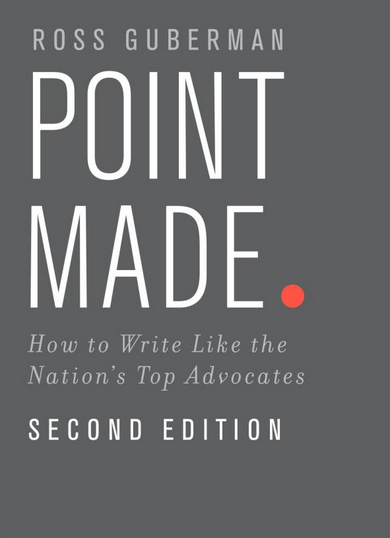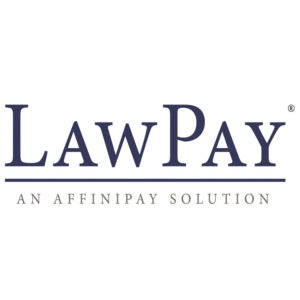 I’m always looking for ways to improve my own writing – legal or otherwise. I think my writing is pretty good (I was number one in legal writing in my class for what it’s worth), but I know I have a long way to go to get it to “great.” Therefore I follow a number of legal (and non-legal) writing blogs look for advice, tips, and deconstruction of good writing. I also regularly consume books on legal writing and general guides on how to become a better lawyer. As such, I was quite pleased when I received a review copy of Ross Guberman’s Point Made: How to Write Like the Nation’s Top Advocates a couple of years ago.
I’m always looking for ways to improve my own writing – legal or otherwise. I think my writing is pretty good (I was number one in legal writing in my class for what it’s worth), but I know I have a long way to go to get it to “great.” Therefore I follow a number of legal (and non-legal) writing blogs look for advice, tips, and deconstruction of good writing. I also regularly consume books on legal writing and general guides on how to become a better lawyer. As such, I was quite pleased when I received a review copy of Ross Guberman’s Point Made: How to Write Like the Nation’s Top Advocates a couple of years ago.
It immediately became a regular “go-to” for me when drafting briefs. It offered numerous tactical and stylistic options to help your writing more clear and arguments more persuasive. Moreover, it did so by displaying such tactics and options by drawing examples from briefs drafted by some of the finest advocates in the country.
The book went on to be quite successful, and now a second edition has been released. I was sent a review copy of the second edition, and my opinion on the book remains largely the same – if you want concrete examples of how to improve your writing, look no further than this book. The second edition includes many new examples from the advocates in the original book, as well as examples from new editions such as Lisa Blatt and Ted Cruz. It also contains more exercises and challenges to help you develop the tactical skills that are displayed in the book. If you never picked up the first edition, you should certainly pick up the second edition – especially considering that the second edition (which includes more material) is currently available for cheaper than the first edition on Amazon! To be able to get this book for $15.98 (as of 4/9/14) is a steal. Go buy it.
Click Here To Buy It Now*Affiliate link.
Below is my review of the first edition:
________
Brass Tacks: Explain “who, what when, where, why, how”
“Too often lawyers jump right into the legal nuances of the case without explaining, in clear terms, the legal context in which the case arises. ” -Wisconsin Supreme Court Chief Justice Shirley Abrahamson
The deeper you are into your litigation, the easier it is to forget what Chief Justice Abrahamson calls the “context in which the case arises.” That’s why so many lawyers’ preliminary statements make you feel as though you’ve been hit over the head with a hammer…
When Attorney General Eric Holder was in private practice at Covington & Burling, he once litigated a high-profile civil case involving bananas, American missionaries, and extortion in Columbia. He and his team started their introduction to a motion to dismiss with a Brass Tacks paragraph telling the court who the parties are, what happened to the plaintiffs, and when and where it happened when they brought their claim, what they want, and why they shouldn’t get it. Holder also squeezes in what the claims are not, highlighting the weakness of the plaintiffs’ case.
Plaintiffs in this action are relatives of five American missionaries who were abducted for ransom and tragically murdered in the mid-1990s by a communist guerilla group in Columbia, known as the Fuerzaz Armadas Revolucionarias de Coumbia. Now, more than a decade later, they seek to hold Chiquita Brands International, Inc. Liable for those deaths under the Antiterrorism Act, and Florida and Nebraska tort law. There is no allegation, however, that Chiquita was involved in the kidnaping and murder of the decedents, that Chiquita intended that these despicable acts occur, or that Chiquita even knew about them until plaintiffs brought this law suit. Instead, plaintiffs allege that Chiquita is liable for decedents’ deaths solely because Chiquita’s former Columbian subsidy made payments extorted by the FARC when this radical Marxist group controlled the remote banana-growing regions of Columbia in which Chiquita’s subsidiary operated.
____________
Point Made is built around such examples. The book is broken into five sections: creating a theme and a compelling introduction (“The Theme”), laying out the facts and crafting a narrative (“The Tale”), structuring your argument (“The Meat”), livening up your style (“The Words”), and crafting a strong conclusion (“The Close”). In each section, Guberman uses examples like the above from some of the best legal writers in the nation to give real world examples of the techniques he describes.
Point Made is not an introductory level book. If you’re not familiar with basic legal writing, you might be better off starting somewhere else. But it might be the best technique oriented legal book I’ve ever read. Where Making Your Case provides what I think is broad, strategical approaches to writing; Point Made is a tactical book. Point Made provides granular-level advice that can immediately be implemented in your writing. I am loathe to come across so effusive in my praise of the book, as to appear biased. But I can’t help but highly recommend the book, it’s that good. If you want to improve your legal writing, pick up a copy of Point Made.
*Affiliate Link













